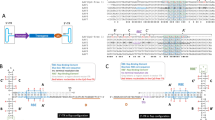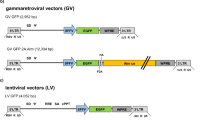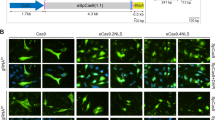Abstract
We previously described Ad-Δ24RGD as an enhanced-infectivity oncolytic adenovirus that targets tumors with an impaired RB pathway. The common alteration of this pathway in cancer eliminates the interaction of pRB with E2F and releases free E2F to activate E2F-responsive promoters, including the E2F-1 promoter. To improve the selectivity towards RB pathway-defective tumors and reduce the toxicity of Ad-Δ24RGD we aimed to control E1A-Δ24 expression under the E2F-1 promoter. A polyA signal was inserted upstream of the E2F-1 promoter to stop transcription initiated at the adenovirus ITR and packaging signal. The human myotonic dystropy locus insulator (DM-1) was also located between the E1a enhancers and the E2F-1 promoter to further insulate the promoter. The Ad-Δ24RGD derivative containing these insulation sequences expressed less E1a-Δ24 in normal cells and resulted less toxic while maintaining the potent oncolytic activity of the parental virus. These results demonstrate that the human DM-1 inslulator can function in an adenovirus context to maintain heterologous promoter selectivity. The new oncolytic adenovirus presented here may represent a valuable therapeutic option for a broad range of tumors with a deregulated E2F/pRB pathway.
This is a preview of subscription content, access via your institution
Access options
Subscribe to this journal
Receive 12 print issues and online access
$259.00 per year
only $21.58 per issue
Buy this article
- Purchase on Springer Link
- Instant access to full article PDF
Prices may be subject to local taxes which are calculated during checkout






Similar content being viewed by others
Accession codes
References
Bischoff JR, Kirn DH, Williams A, Heise C, Horn S, Muna M et al. An adenovirus mutant that replicates selectively in p53-deficient human tumor cells. Science 1996; 274: 373–376.
Fueyo J, Gomez-Manzano C, Alemany R, Lee PS, McDonnell TJ, Mitlianga P et al. A mutant oncolytic adenovirus targeting the Rb pathway produces anti-glioma effect in vivo. Oncogene 2000; 19: 2–12.
Cascallo M, Capella G, Mazo A, Alemany R . Ras-dependent oncolysis with an adenovirus VAI mutant. Cancer Res 2003; 63: 5544–5550.
Hallenbeck PL, Chang YN, Hay C, Golightly D, Stewart D, Lin J et al. A novel tumor-specific replication-restricted adenoviral vector for gene therapy of hepatocellular carcinoma. Hum Gene Ther 1999; 10: 1721–1733.
Rodriguez R, Schuur ER, Lim HY, Henderson GA, Simons JW, Henderson DR . Prostate attenuated replication competent adenovirus (ARCA) CN706: a selective cytotoxic for prostate-specific antigen-positive prostate cancer cells. Cancer Res 1997; 57: 2559–2563.
Nettelbeck DM, Rivera AA, Balague C, Alemany R, Curiel DT . Novel oncolytic adenoviruses targeted to melanoma: specific viral replication and cytolysis by expression of E1A mutants from the tyrosinase enhancer/promoter. Cancer Res 2002; 62: 4663–4670.
Alemany R, Suzuki K, Curiel DT . Blood clearance rates of adenovirus type 5 in mice. J Gen Virol 2000; 81: 2605–2609.
Bernt KM, Ni S, Gaggar A, Li ZY, Shayakhmetov DM, Lieber A . The effect of sequestration by nontarget tissues on anti-tumor efficacy of systemically applied, conditionally replicating adenovirus vectors. Mol Ther 2003; 8: 746–755.
Lieber A, He CY, Meuse L, Schowalter D, Kirillova I, Winther B et al. The role of Kupffer cell activation and viral gene expression in early liver toxicity after infusion of recombinant adenovirus vectors. J Virol 1997; 71: 8798–8807.
Liu Q, Zaiss AK, Colarusso P, Patel K, Haljan G, Wickham TJ et al. The role of capsid-endothelial interactions in the innate immune response to adenovirus vectors. Hum Gene Ther 2003; 14: 627–643.
Worgall S, Wolff G, Falck-Pedersen E, Crystal RG . Innate immune mechanisms dominate elimination of adenoviral vectors following in vivo administration. Hum Gene Ther 1997; 8: 37–44.
Tao N, Gao GP, Parr M, Johnston J, Baradet T, Wilson JM et al. Sequestration of adenoviral vector by Kupffer cells leads to a nonlinear dose response of transduction in liver. Mol Ther 2001; 3: 28–35.
Engler H, Machemer T, Philopena J, Wen SF, Quijano E, Ramachandra M et al. Acute hepatotoxicity of oncolytic adenoviruses in mouse models is associated with expression of wild-type E1a and induction of TNF-alpha. Virology 2004; 328: 52–61.
Johnson L, Shen A, Boyle L, Kunich J, Pandey K, Lemmon M et al. Selectively replicating adenoviruses targeting deregulated E2F activity are potent, systemic antitumor agents. Cancer Cell 2002; 1: 325–337.
Jakubczak JL, Ryan P, Gorziglia M, Clarke L, Hawkins LK, Hay C et al. An oncolytic adenovirus selective for retinoblastoma tumor suppressor protein pathway-defective tumors: dependence on E1A, the E2F-1 promoter, and viral replication for selectivity and efficacy. Cancer Res 2003; 63: 1490–1499.
Tsukuda K, Wiewrodt R, Molnar-Kimber K, Jovanovic VP, Amin KM . An E2F-responsive replication-selective adenovirus targeted to the defective cell cycle in cancer cells: potent antitumoral efficacy but no toxicity to normal cell. Cancer Res 2002; 62: 3438–3447.
Helin K . Regulation of cell proliferation by the E2F transcription factors. Curr Opin Genet Dev 1998; 8: 28–35.
Johnson DG, Schneider-Broussard R . Role of E2F in cell cycle control and cancer. Front Biosci 1998; 3: d447–d448.
Dyson N . The regulation of E2F by pRB-family proteins. Genes Dev 1998; 12: 2245–2262.
Nevins JR . The Rb/E2F pathway and cancer. Hum Mol Genet 2001; 10: 699–703.
Ring CJ, Harris JD, Hurst HC, Lemoine NR . Suicide gene expression induced in tumour cells transduced with recombinant adenoviral, retroviral and plasmid vectors containing the ERBB2 promoter. Gene Therapy 1996; 3: 1094–1103.
Shi Q, Wang Y, Worton R . Modulation of the specificity and activity of a cellular promoter in an adenoviral vector. Hum Gene Ther 1997; 8: 403–410.
Buvoli M, Langer SJ, Bialik S, Leinwand LA . Potential limitations of transcription terminators used as transgene insulators in adenoviral vectors. Gene Therapy 2002; 9: 227–231.
Yamamoto M, Davydova J, Takayama K, Alemany R, Curiel DT . Transcription initiation activity of adenovirus left-end sequence in adenovirus vectors with E1 deleted. J Virol 2003; 77: 1633–1637.
Vassaux G, Hurst HC, Lemoine NR . Insulation of a conditionally expressed transgene in an adenoviral vector. Gene Therapy 1999; 6: 1192–1197.
Hearing P, Shenk T . The adenovirus type 5 E1A enhancer contains two functionally distinct domains: one is specific for E1A and the other modulates all early units in cis. Cell 1986; 45: 229–236.
Steinwaerder DS, Lieber A . Insulation from viral transcriptional regulatory elements improves inducible transgene expression from adenovirus vectors in vitro and in vivo. Gene Therapy 2000; 7: 556–567.
Martin-Duque P, Jezzard S, Kaftansis L, Vassaux G . Direct comparison of the insulating properties of two genetic elements in an adenoviral vector containing two different expression cassettes. Hum Gene Ther 2004; 15: 995–1002.
West AG, Gaszner M, Felsenfeld G . Insulators: many functions, many mechanisms. Genes Dev 2002; 16: 271–288.
Filippova GN, Thienes CP, Penn BH, Cho DH, Hu YJ, Moore JM et al. CTCF-binding sites flank CTG/CAG repeats and form a methylation-sensitive insulator at the DM1 locus. Nat Genet 2001; 28: 335–343.
Suzuki K, Fueyo J, Krasnykh V, Reynolds PN, Curiel DT, Alemany R . A conditionally replicative adenovirus with enhanced infectivity shows improved oncolytic potency. Clin Cancer Res 2001; 7: 120–126.
Villanueva A, Garcia C, Paules AB, Vicente M, Megias M, Reyes G et al. Disruption of the antiproliferative TGF-beta signaling pathways in human pancreatic cancer cells. Oncogene 1998; 17: 1969–1978.
Grompe M, Jones SN, Loulseged H, Caskey CT . Retroviral-mediated gene transfer of human ornithine transcarbamylase into primary hepatocytes of spf and spf-ash mice. Hum Gene Ther 1992; 3: 35–44.
Castell JV, Hernandez D, Gomez-Foix AM, Guillen I, Donato T, Gomez-Lechon MJ . Adenovirus-mediated gene transfer into human hepatocytes: analysis of the biochemical functionality of transduced cells. Gene Therapy 1997; 4: 455–464.
He TC, Zhou S, da Costa LT, Yu J, Kinzler KW, Vogelstein B . A simplified system for generating recombinant adenoviruses. Proc Natl Acad Sci USA 1998; 95: 2509–2514.
Dmitriev I, Krasnykh V, Miller CR, Wang M, Kashentseva E, Mikheeva G et al. An adenovirus vector with genetically modified fibers demonstrates expanded tropism via utilization of a coxsackievirus and adenovirus receptor-independent cell entry mechanism. J Virol 1998; 72: 9706–9713.
Sauthoff H, Pipiya T, Heitner S, Chen S, Bleck B, Reibman J et al. Impact of E1a modifications on tumor-selective adenoviral replication and toxicity. Mol Ther 2004; 10: 749–757.
Heise C, Hermiston T, Johnson L, Brooks G, Sampson-Johannes A, Williams A et al. An adenovirus E1A mutant that demonstrates potent and selective systemic anti-tumoral efficacy. Nat Med 2000; 6: 1134–1139.
Balague C, Noya F, Alemany R, Chow LT, Curiel DT . Human papillomavirus E6E7-mediated adenovirus cell killing: selectivity of mutant adenovirus replication in organotypic cultures of human keratinocytes. J Virol 2001; 75: 7602–7611.
Geoerger B, Vassal G, Opolon P, Dirven CM, Morizet J, Laudani L et al. Oncolytic activity of p53-expressing conditionally replicative adenovirus AdDelta24-p53 against human malignant glioma. Cancer Res 2004; 64: 5753–5759.
Duncan SJ, Gordon FC, Gregory DW, McPhie JL, Postlethwaite R, White R et al. Infection of mouse liver by human adenovirus type 5. J Gen Virol 1978; 40: 45–61.
Heise C, Sampson-Johannes A, Williams A, McCormick F, Von Hoff DD, Kirn DH . ONYX-015, an E1B gene-attenuated adenovirus, causes tumor-specific cytolysis and antitumoral efficacy that can be augmented by standard chemotherapeutic agents. Nat Med 1997; 3: 639–645.
Ryan PC, Jakubczak JL, Stewart DA, Hawkins LK, Cheng C, Clarke LM et al. Antitumor efficacy and tumor-selective replication with a single intravenous injection of OAS403, an oncolytic adenovirus dependent on two prevalent alterations in human cancer. Cancer Gene Ther 2004; 11: 555–569.
Hitt MM, Graham FL . Adenovirus E1A under the control of heterologous promoters: wide variation in E1A expression levels has little effect on virus replication. Virology 1990; 179: 667–678.
Kozak M . Point mutations define a sequence flanking the AUG initiator codon that modulates translation by eukaryotic ribosomes. Cell 1986; 44: 283–292.
Fessler SP, Young CS . Control of adenovirus early gene expression during the late phase of infection. J Virol 1998; 72: 4049–4056.
Taki M, Kagawa S, Nishizaki M, Mizuguchi H, Hayakawa T, Kyo S et al. Enhanced oncolysis by a tropism-modified telomerase-specific replication-selective adenoviral agent OBP-405 (‘Telomelysin-RGD’). Oncogene 2005; 24: 3130–3140.
Lamfers ML, Grill J, Dirven CM, Van Beusechem VW, Geoerger B, Van Den Berg J et al. Potential of the conditionally replicative adenovirus Ad5-Delta24RGD in the treatment of malignant gliomas and its enhanced effect with radiotherapy. Cancer Res 2002; 62: 5736–5742.
Acknowledgements
We thank pathologist Felip Vilardell for procurement of human liver. We also wish to thank Alena Gros, Jordi Martinez-Quintanilla, Anna Pérez and Blanca Luengo for their technical support. Research funding was provided by SAF2002-04122-C03-01 to RA from the ‘Ministerio de Ciencia y Tecnologia’ of Spain and by a grant from the Sociedad Española de Oncología Médica (SEOM). The research team belongs to the Network of Cooperative Research on Cancer (C03/10), funded by the Instituto Carlos III of the Ministerio de Sanidad y Consumo of Spain.
Author information
Authors and Affiliations
Corresponding author
Rights and permissions
About this article
Cite this article
Majem, M., Cascallo, M., Bayo-Puxan, N. et al. Control of E1A under an E2F-1 promoter insulated with the myotonic dystrophy locus insulator reduces the toxicity of oncolytic adenovirus Ad-Δ24RGD. Cancer Gene Ther 13, 696–705 (2006). https://doi.org/10.1038/sj.cgt.7700940
Received:
Revised:
Accepted:
Published:
Issue Date:
DOI: https://doi.org/10.1038/sj.cgt.7700940
Keywords
This article is cited by
-
A potential bat adenovirus-based oncolytic virus targeting canine cancers
Scientific Reports (2021)
-
Verapamil Enhances the Antitumoral Efficacy of Oncolytic Adenoviruses
Molecular Therapy (2010)
-
Treatment of metastatic neuroblastoma with systemic oncolytic virotherapy delivered by autologous mesenchymal stem cells: an exploratory study
Cancer Gene Therapy (2010)
-
A modified E2F-1 promoter improves the efficacy to toxicity ratio of oncolytic adenoviruses
Gene Therapy (2009)
-
Syncytia formation affects the yield and cytotoxicity of an adenovirus expressing a fusogenic glycoprotein at a late stage of replication
Gene Therapy (2008)



